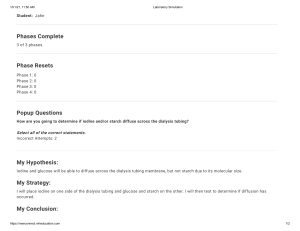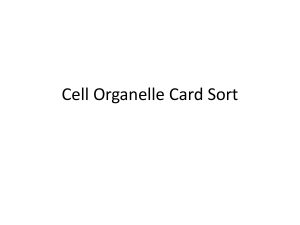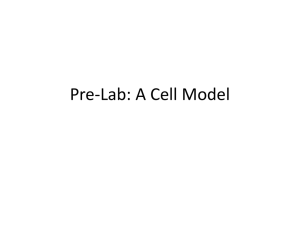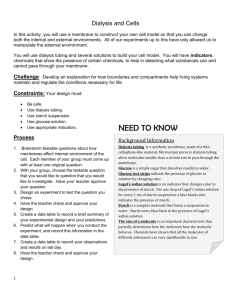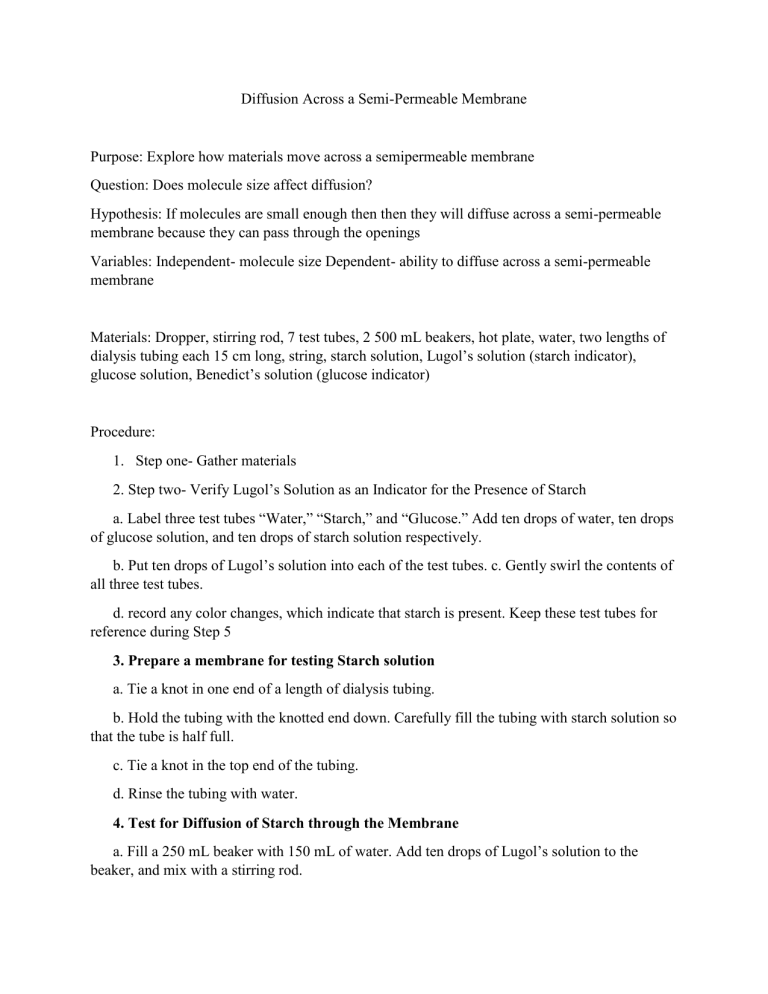
Diffusion Across a Semi-Permeable Membrane Purpose: Explore how materials move across a semipermeable membrane Question: Does molecule size affect diffusion? Hypothesis: If molecules are small enough then then they will diffuse across a semi-permeable membrane because they can pass through the openings Variables: Independent- molecule size Dependent- ability to diffuse across a semi-permeable membrane Materials: Dropper, stirring rod, 7 test tubes, 2 500 mL beakers, hot plate, water, two lengths of dialysis tubing each 15 cm long, string, starch solution, Lugol’s solution (starch indicator), glucose solution, Benedict’s solution (glucose indicator) Procedure: 1. Step one- Gather materials 2. Step two- Verify Lugol’s Solution as an Indicator for the Presence of Starch a. Label three test tubes “Water,” “Starch,” and “Glucose.” Add ten drops of water, ten drops of glucose solution, and ten drops of starch solution respectively. b. Put ten drops of Lugol’s solution into each of the test tubes. c. Gently swirl the contents of all three test tubes. d. record any color changes, which indicate that starch is present. Keep these test tubes for reference during Step 5 3. Prepare a membrane for testing Starch solution a. Tie a knot in one end of a length of dialysis tubing. b. Hold the tubing with the knotted end down. Carefully fill the tubing with starch solution so that the tube is half full. c. Tie a knot in the top end of the tubing. d. Rinse the tubing with water. 4. Test for Diffusion of Starch through the Membrane a. Fill a 250 mL beaker with 150 mL of water. Add ten drops of Lugol’s solution to the beaker, and mix with a stirring rod. b. Place the tubing into the beaker. Observe the solution in the beaker and the dialysis tube; record your observations in the data table. c. Wait 15 minutes. Note the color of the solution in the beaker and the dialysis tube; record the results in the data table. d. Did starch diffuse through the membrane? Record your answer and reason in the data table. 5. Verify Benedict’s Solution as an Indicator for the Presence of Glucose a. Label three test tubes “Water,” “Starch,” and “Glucose.” Add ten drops of water, ten drops of glucose solution, and ten drops of starch solution respectively b. Put ten drops of Benedict’s solution into each of the test tubes. c. Place the test tubes in a water bath on the hot plate. Heat for five minutes. d. In your data table, record any color changes, which indicate that glucose is present. If the indicator solution works properly, only the test tube with glucose solution should show a change. Keep these test tubes for reference during step 7. 6. Prepare a “Membrane” for Testing Glucose Solution a. Repeat steps 3a through 3d exactly except with the glucose solution 7. Test for Diffusion of Glucose through the Membrane a. Fill a 250 mL beaker with 150 mL of water. Add ten drops of Benedict’s solution to the beaker and mix with a stirring rod. B. Place the tubing into the beaker. Observe the solution in the beaker and the dialysis tube. Record your observations in the data table. c. Wait fifteen minutes. Transfer ten drops of the solution in the beaker to a test tube. d. Place the test tube in a hot water bath, and wait for five minutes. Note the color of the solution in the test tube taken from the beaker. Record the results in the data table. e. Did glucose diffuse through the membrane? Record your answer and reason in the data table. 8. Dispose of all materials properly Indicator Test Color Change Due to Lugol’s Solution (starch indicator) Color Change Due to Benedict’s Solution (glucose indicator) Water Starch solution Glucose water Orange/salmon purple Orange/salmon blue red blue Diffusion Tests Color of Solution in Dialysis Tube Color of Solution in Beaker Was there diffusion? Step 4: Test for Diffusion of Starch Initial color: yellow Color after 15 minutes: yellow Initial color: yellow Color after 15 minutes: dark purple no Step 7: Test for Diffusion of Glucose Initial color: white/grey Color after 15 minutes: red yes Analysis: The independent variable, molecule size, directly affects the dependent variable, ability to diffuse across a semi-permeable membrane. Only the smaller molecules which in this experiment was the glucose could diffuse. Conclusion: The hypothesis that if molecules are small enough then then they will diffuse across a semipermeable membrane because they can pass through the openings was supported by the experiment. Starch has a larger molecule size so it could not diffuse unlike glucose which could because the molecules are small. To further improve this experiment, you could test more solutions with a wider variety of molecule sizes.

